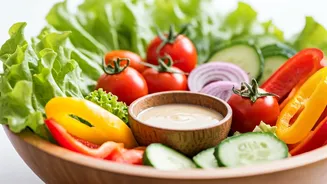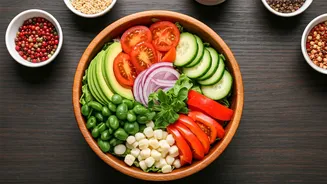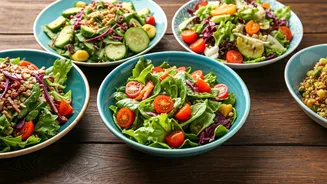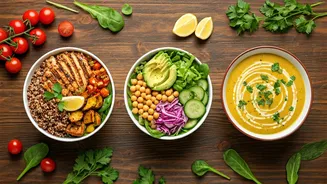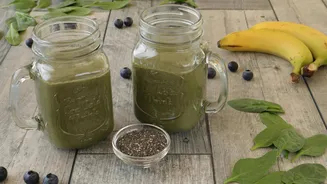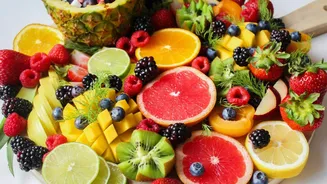Refreshing Green Salads
Kick things off with a classic: the simple green salad! This versatile base allows for endless variations. Start with a bed of crisp lettuce, like romaine
or butter lettuce. Add your favorite vegetables – cucumbers, bell peppers, and cherry tomatoes are great choices. For a protein boost, include grilled chicken or chickpeas. Don't forget the dressing! A light vinaigrette, made with olive oil, vinegar, and herbs, complements the fresh ingredients. Experiment with different types of greens, like spinach or kale, to increase the nutritional value of your salad. Consider adding crunchy croutons or toasted nuts for extra texture. To prevent the salad from becoming soggy, add the dressing just before serving. This simple approach ensures a healthy and satisfying meal that is easy to prepare at any time.
Vibrant Tomato Salads
Next, let's explore the world of tomato-based salads! These salads are bursting with flavor, especially during tomato season. A Caprese salad, with sliced tomatoes, fresh mozzarella, and basil, drizzled with balsamic glaze, is a perfect example. Another option is a Mediterranean salad featuring juicy tomatoes, cucumbers, red onion, Kalamata olives, and feta cheese, tossed in a lemon-herb vinaigrette. For something different, try a tomato and avocado salad. Combine ripe tomatoes, creamy avocado, and a zesty lime dressing. Consider adding a pinch of red pepper flakes for a little kick. Ensure the tomatoes are ripe and flavorful for the best results. These salads are not only delicious but also packed with antioxidants and essential nutrients. They make a colorful and healthy addition to any meal, providing a refreshing taste.
Hearty Grain Salads
Grain salads are a fantastic way to create a filling and nutritious meal. Quinoa, farro, and barley are excellent base choices. Cook the grain according to package instructions, and let it cool. Then, add a variety of ingredients, such as roasted vegetables (sweet potatoes, Brussels sprouts), beans, nuts, and a flavorful dressing. A quinoa salad with black beans, corn, bell peppers, and a cilantro-lime dressing is an excellent choice. Farro salads with roasted vegetables and a lemon-herb vinaigrette are also popular. For added protein, include grilled chicken, chickpeas, or lentils. Grain salads are very versatile, and you can easily customize them to suit your taste. These salads are perfect for meal prepping because the grains hold up well and the flavors meld together over time. They are ideal for a light lunch or a satisfying dinner.
Creamy Pasta Salads
Pasta salads are a beloved dish for picnics and potlucks! Cook your favorite pasta shapes, such as rotini or penne, and let them cool completely. Then, combine the pasta with a variety of ingredients and a creamy dressing. A classic pasta salad includes pasta, cherry tomatoes, cucumbers, olives, and a creamy Italian dressing. Another option is a pasta salad with pesto, sun-dried tomatoes, and mozzarella balls. For something different, try a creamy macaroni salad with mayonnaise, celery, and onion. Remember to avoid overcooking the pasta, as it will become mushy. Pasta salads are perfect for making ahead of time. The flavors improve as they sit in the refrigerator. Use fresh herbs and high-quality ingredients for the best taste. These salads provide a delicious and satisfying option for various occasions.
Exotic Fruit Salads
Fruit salads offer a refreshing and naturally sweet option. Combine a variety of fresh fruits to create a delightful mix. A summer fruit salad could include watermelon, cantaloupe, strawberries, and blueberries. For a tropical twist, use mango, pineapple, kiwi, and coconut flakes. Consider adding a squeeze of lime juice or a sprinkle of mint to enhance the flavors. These salads are naturally low in calories and packed with vitamins and antioxidants. Ensure the fruits are ripe and at their peak flavor for the best taste. You can also add a dollop of yogurt or a drizzle of honey for added sweetness and creaminess. Fruit salads are not just delicious; they are also visually appealing, making them a great addition to any gathering. They are perfect as a light dessert or a refreshing snack.
Bean & Legume Salads
Bean and legume salads are both nutritious and filling, making them excellent choices for lunch or a light dinner. A three-bean salad is a classic, combining green beans, kidney beans, and chickpeas in a vinaigrette dressing. You can also add onions and bell peppers for extra flavor. A black bean and corn salad with a lime dressing is another delicious and vibrant option. Add some diced avocado for creaminess. Lentil salads are also a great choice. Cook the lentils and combine them with chopped vegetables, herbs, and a lemon-herb vinaigrette. Bean and legume salads are packed with protein and fiber, helping you feel satisfied for longer. They're also budget-friendly and easy to prepare. These salads are a simple way to incorporate more plant-based protein into your diet, offering a healthy and tasty option.
Crunchy Slaw Salads
Coleslaw offers a delightful combination of crunch and flavor, making it a popular side dish. The base of coleslaw typically involves shredded cabbage, but you can experiment with different types like red or Savoy cabbage for variety. The dressing is crucial. A classic coleslaw dressing is made with mayonnaise, vinegar, sugar, and seasonings. You can make it tangy with a touch of mustard or a bit of lemon juice. Another option is a vinegar-based slaw, which is lighter and more refreshing. Add other ingredients to your slaw like shredded carrots, red onion, and celery for added flavor and texture. For a twist, try adding chopped apple or a handful of dried cranberries for sweetness. Coleslaw is a great addition to BBQs or picnics. It’s also a perfect side for sandwiches and grilled meats.
Unique Salad Dressings
Elevate your salads with homemade salad dressings. Creating your own dressing is simple and allows you to customize the flavors to your preferences. A basic vinaigrette is a mix of oil, vinegar, and seasonings. Experiment with different types of oil, such as olive oil, avocado oil, or sesame oil. Choose various vinegars like balsamic, red wine, or apple cider. Seasonings can include herbs, spices, garlic, and onion. For creamy dressings, use a base of mayonnaise, yogurt, or tahini. Add fresh herbs like dill, parsley, or chives for extra flavor. Homemade dressings are fresher, healthier, and allow you to control the ingredients. Create an Asian-inspired dressing with sesame oil, soy sauce, and ginger. A creamy avocado dressing adds richness and healthy fats. Dressings make the salads exceptional.
Salad Topping Ideas
Enhance your salads with various toppings for flavor and texture! Add a crunch by using toasted nuts, seeds, or croutons. Nuts like walnuts, pecans, or almonds provide healthy fats and a satisfying crunch. Seeds such as sunflower, pumpkin, or chia add a nutritional boost. For extra protein, add grilled chicken, hard-boiled eggs, or chickpeas. Crumble some cheese like feta, goat cheese, or blue cheese to boost flavor. Include dried fruits such as cranberries or raisins for sweetness and texture. Sprinkle your salads with fresh herbs like parsley, cilantro, or basil to enhance the taste and visual appeal. Toppings make your salads more exciting, delicious, and satisfying. Varying the toppings will keep your salads interesting, preventing boredom and increasing your daily nutrient intake, promoting overall health and wellness.
Seasonal Salad Recipes
Embrace seasonal ingredients to create the most flavorful salads. In the spring, use fresh greens, asparagus, peas, and radishes. Summer brings ripe tomatoes, cucumbers, corn, and berries. Autumn is perfect for roasted root vegetables like sweet potatoes and squash. Winter salads can feature hearty greens, citrus fruits, and pomegranates. Use seasonal produce to make the most of each season's flavors and nutrients. Seasonal salads are often more flavorful and cost-effective. Check your local farmers market or grocery store for inspiration. Combine fresh seasonal produce with your favorite dressings and toppings. This will help you to enjoy unique, healthy, and delicious salads all year round, providing a constant variety of tastes and textures. Try experimenting with different seasonal combinations.
Salad Preparation Tips
Proper preparation is key to making amazing salads. Wash and dry your greens thoroughly to remove any dirt or grit. Use a salad spinner to remove excess water, which helps the dressing stick to the leaves. Chop vegetables to a uniform size for even distribution of flavors. Prepare the dressing separately and add it just before serving to prevent the salad from becoming soggy. Store prepped ingredients separately to maintain freshness. Keep the dressing in a separate container and add it just before serving. If you're using protein, grill or cook it ahead of time. Use quality ingredients, and choose seasonal, fresh produce whenever possible. With careful preparation and the right techniques, your salads will be exceptionally fresh, flavorful, and a delight to eat. These simple tips can significantly improve your salad experience.
Salad Storage Techniques
Learn how to store salads to keep them fresh and delicious for longer. Wash and dry the lettuce and store it in the refrigerator in a container lined with paper towels. The paper towels will absorb excess moisture, helping the lettuce to stay crisp. Store prepped vegetables separately, preventing them from wilting. Store dressings in a separate airtight container. Avoid adding dressing to the salad until just before serving. This will prevent the salad from becoming soggy. If you have leftovers, store them in an airtight container in the refrigerator. Leftover salads are generally safe to eat for up to 2-3 days. Consider arranging ingredients in layers, starting with the heartier items like vegetables at the bottom. Proper storage ensures your salads stay fresh, crisp, and enjoyable, helping reduce food waste. Proper storage keeps your salads ready for a quick and healthy meal.
Salad Customization Tips
Customize your salads to suit your tastes and dietary needs. Experiment with different types of greens, from romaine to spinach, and kale. Add a variety of vegetables for added nutrients and flavors. Consider including a protein source, such as grilled chicken, chickpeas, or tofu. Add nuts, seeds, or croutons for a satisfying crunch. Choose dressings that fit your preferences, from light vinaigrettes to creamy dressings. Adjust the ingredients to your health goals, such as by using low-fat options or avoiding certain allergens. Customization allows you to create salads that are perfectly tailored to your likes and dislikes. This also helps in meeting your daily nutritional requirements in a tasty and fulfilling manner. These tips empower you to create salads that are perfectly suited to your preferences.
Building Balanced Salads
Create nutritionally balanced salads by incorporating various food groups. Include a base of leafy greens, which are rich in vitamins and fiber. Add a protein source, such as grilled chicken, beans, or tofu, for satiety. Add healthy fats from sources such as avocado, nuts, or seeds. Include complex carbohydrates from grains, sweet potatoes, or beans. Add colorful vegetables, such as bell peppers, tomatoes, and cucumbers, for vitamins and minerals. Choose a dressing that is made with healthy fats and minimal added sugars. A well-balanced salad provides all essential nutrients while offering variety in flavors and textures. Building balanced salads is key to maintaining a healthy diet. This will help you maintain your energy levels throughout the day.
Salad FAQs and Tips
Here are some frequently asked questions about salads: How long do salads last? Typically, prepared salads will last for 2-3 days if stored properly. Can I make salads ahead of time? Yes, you can prep ingredients ahead but add dressing just before serving. What kind of dressing is healthiest? Olive oil-based vinaigrettes are generally considered healthier. What are some good salad alternatives? Try wraps with similar ingredients or lettuce cups. Remember to add your personal touch by using seasonal ingredients, creating homemade dressings, and experimenting with toppings. By following these tips and answering common questions, you'll be well on your way to creating delicious, nutritious, and satisfying salads every time. Salads are a versatile food, making it easy to create flavorful meals.
